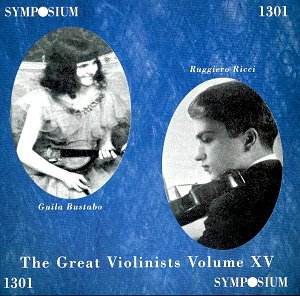AVAILABILITY
www.symposiumrecords.co.uk
Two Americans violinists were born in successive
years and nearly a continent apart. The older, by a year, was
Guila Bustabo, Wisconsin born in 1917 and the other was Ruggiero
Ricci. Both studied with the leading American pedagogue of the
day Louis Persinger and both soon gravitated to Europe. Bustabo
enjoyed the greater early celebrity, making her London debut in
1934 and recording talent scouts were clearly out in force as
she went into the studios the following year to record with Gerald
Moore. She was eighteen. Ricci studied with Kulenkampff in Germany
but the early days were for him days of struggle and complication
and blighted by family problems and custody battles. He did though
manage to record a number of sides in the late 1930s before, unlike
Bustabo, he returned to America.
These are the sides that Symposium has collated
in Volume XV of their Great Violinist series. The yoking together
of these two figures is both appropriate therefore and salutary.
Bustabo, like Ricci, was a technical gymnast of a quite extraordinary
kind and at eighteen was already set for an international career.
She exhibits stunning virtuosity here though wisely she was asked
to balance the finger-busting Sarasate, Novacek and Paganini with
a little Mendelssohn and Chopin. The Novacek is strongly etched
and accented and the Paganini Concerto’s first movement cadenza
is magnificently despatched with some truly ear-catching precision.
But, this early in her career there are also negative evaluations
to be made of her musicianship. Her vibrato could incline to the
queasy, as it does in the Mendelssohn, with the swells and ardently
youthful playing impressive in the lower strings and double stopping
but less convincing in total. In the Chopin Nocturne her tone,
perversely, seems rather thin and there is some technical untidiness;
the phrasing is rather lacking in naturalness as well and Gerald
Moore, valiant though he is, is only semi-audible. He sounds thoroughly
bemused by his violinist partner in the Kreisler, whose rhythmic
unsteadiness and capricious phraseology lead him a merry dance.
In 1941, in Germany, she recorded Sarasate’s Habañera and
here her tone sounds distinctly nasal though the virtuosity is
quite undimmed. It was around this time that she and Mengelberg
were taped in a splendid series of concerto performances of which
the Bruch G minor was without question the most radiant and marvellous.
It’s one of the very best performances ever recorded of this piece
and shows her at her best. Bustabo has been celebrated by ‘A Classical
Record’ whose set included her Sibelius and Wolf-Ferrari Concertos
amongst much else. Admirers should seek it out.
Ricci is represented by eight items from 1938-39.
There are some romantic pieces here as well as a fine slew of
virtuoso showpieces – sinewy vibrato in Paganini’s Variations
on Mosè, devilish panache in Ronde a la clochette, a cholesterol
rich Sarasate Introduction and Tarantella, a truly swaggering
Habañera but also, often overlooked, the lyric intensity
and expressive nuance of Ysaye’s Rêve d’enfant. Zigeunerweisen,
the warhorse of warhorses, has some daredevil attack in the Allegro
molto vivace section and is a powerfully propulsive and energized
performance. It also features a fine ear for dynamic variance,
and though seeming fast still manages perfectly to articulate.
It’s a pity that the Mattheson Air in B is missing because this
was a most affecting performance but the Ysaÿe is splendid.
One of the best pieces here is Michael Press’ arrangement of Vocalise
with Ricci’s lasciviously intense vibrato held in check and all
the more affecting for it. I reviewed a number of these Ricci
items recently in a Dynamic 10 CD celebration. That would be an
unwieldy purchase but this one has slightly better transfers of
the source material and avoids doing what Dynamic did to Ricci’s
Zigeunerweisen – which is separately to track it, as if it was
a Sonata.
Good apposite notes are here and this disc captures
two contemporaries whose lives took them in radically different
directions but whose musical instincts never deserted them.
Jonathan Woolf

